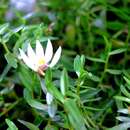en
names in breadcrumbs


Lobelia chinensis, commonly known as Asian lobelia,[2] Chinese lobelia, and Herba Lobellae Chinensis, is a species of flowering plant in the family Campanulaceae. It is one of the 50 fundamental herbs used in traditional Chinese medicine, where it has the name (Chinese: 半边莲; pinyin: bàn biān lián).[3]
Lobelia chinensis is a small perennial herb[4] that grows in tangled clumps from 15 centimetres (5.9 in) to 35 centimetres (14 in) long. It has a long, thin, branching stem that is olive green and green-brown crumpled narrow leaves. It has little to no odor and a sweet and pungent taste. When harvesting herbs for medical use, the ones with the greenest stems and yellower roots are preferred.[3]
It is endemic to east, south, southwest, and south-central China.
Lobelia chinensis is considered one of the 50 fundamental herbs in Chinese herbology. Historically, L. chinensis has been used in herbal medicine to help stop smoking, however the Food and Drug Administration has banned the use of herbs containing lobeline due to its ineffectiveness.[5]
Lobelia chinensis contains 6,7-dimethoxycoumarin, fraxinol, 5-hydroxy-7-methoxycoumarin, tomentin, 3'-hydroxygenkwanin, apigenin, quercetin, luteolin, linarin, luteolin 3',4'-dimethylether-7-O-beta-D-glucoside, isoferulic acid, and ethyl rosmarinate.[6]
Lobelia chinensis is considered mildly toxic[1] due to its adverse effects, including vomiting, heartburn, anxiety, vibrating, eclampsia, increased heart-rate, and severe stomach aches.[7]
{{cite web}}: Missing or empty |url= (help) Lobelia chinensis, commonly known as Asian lobelia, Chinese lobelia, and Herba Lobellae Chinensis, is a species of flowering plant in the family Campanulaceae. It is one of the 50 fundamental herbs used in traditional Chinese medicine, where it has the name (Chinese: 半边莲; pinyin: bàn biān lián).